ors CHRYSLER CARAVAN 2005 Service Manual
[x] Cancel search | Manufacturer: CHRYSLER, Model Year: 2005, Model line: CARAVAN, Model: CHRYSLER CARAVAN 2005Pages: 2339, PDF Size: 59.69 MB
Page 465 of 2339
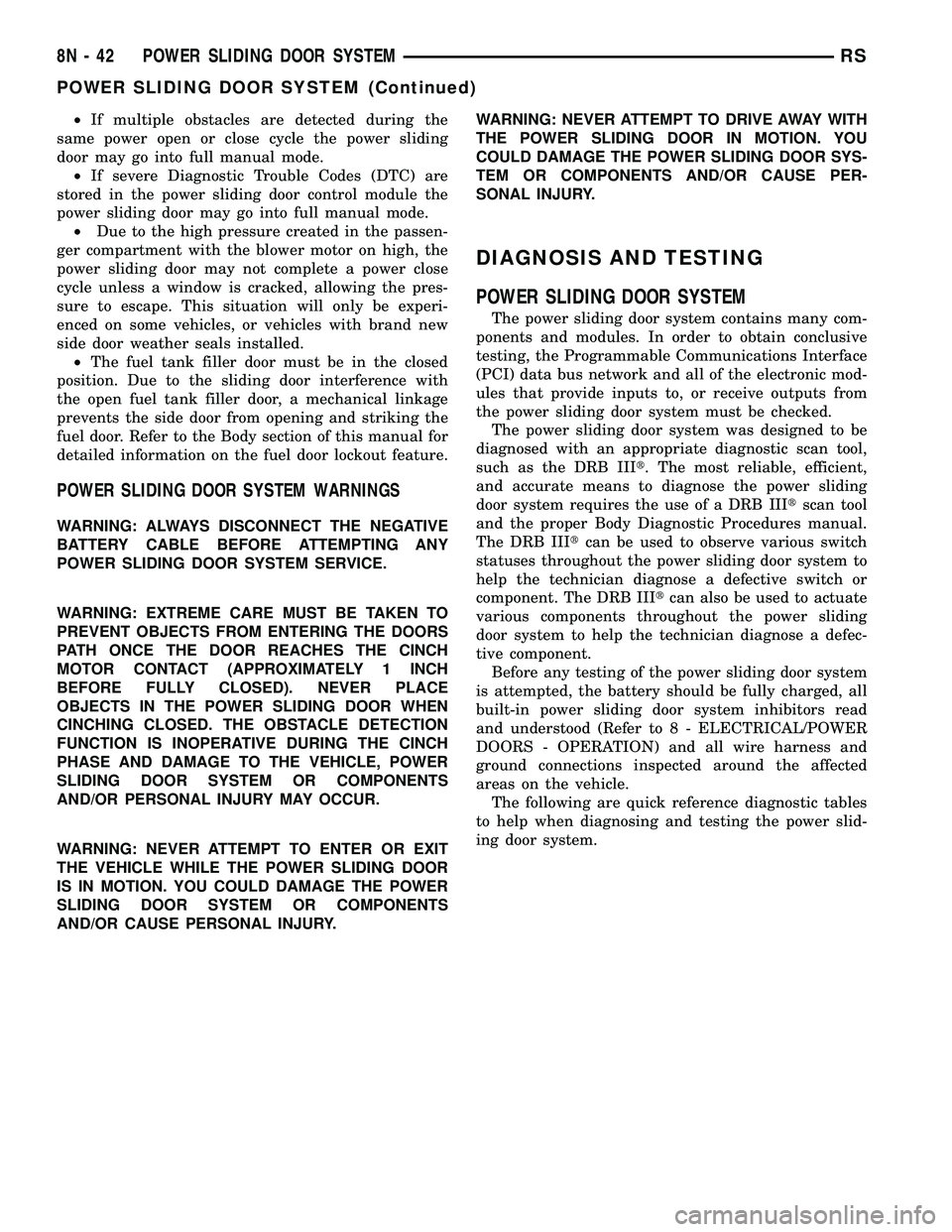
²If multiple obstacles are detected during the
same power open or close cycle the power sliding
door may go into full manual mode.
²If severe Diagnostic Trouble Codes (DTC) are
stored in the power sliding door control module the
power sliding door may go into full manual mode.
²Due to the high pressure created in the passen-
ger compartment with the blower motor on high, the
power sliding door may not complete a power close
cycle unless a window is cracked, allowing the pres-
sure to escape. This situation will only be experi-
enced on some vehicles, or vehicles with brand new
side door weather seals installed.
²The fuel tank filler door must be in the closed
position. Due to the sliding door interference with
the open fuel tank filler door, a mechanical linkage
prevents the side door from opening and striking the
fuel door. Refer to the Body section of this manual for
detailed information on the fuel door lockout feature.
POWER SLIDING DOOR SYSTEM WARNINGS
WARNING: ALWAYS DISCONNECT THE NEGATIVE
BATTERY CABLE BEFORE ATTEMPTING ANY
POWER SLIDING DOOR SYSTEM SERVICE.
WARNING: EXTREME CARE MUST BE TAKEN TO
PREVENT OBJECTS FROM ENTERING THE DOORS
PATH ONCE THE DOOR REACHES THE CINCH
MOTOR CONTACT (APPROXIMATELY 1 INCH
BEFORE FULLY CLOSED). NEVER PLACE
OBJECTS IN THE POWER SLIDING DOOR WHEN
CINCHING CLOSED. THE OBSTACLE DETECTION
FUNCTION IS INOPERATIVE DURING THE CINCH
PHASE AND DAMAGE TO THE VEHICLE, POWER
SLIDING DOOR SYSTEM OR COMPONENTS
AND/OR PERSONAL INJURY MAY OCCUR.
WARNING: NEVER ATTEMPT TO ENTER OR EXIT
THE VEHICLE WHILE THE POWER SLIDING DOOR
IS IN MOTION. YOU COULD DAMAGE THE POWER
SLIDING DOOR SYSTEM OR COMPONENTS
AND/OR CAUSE PERSONAL INJURY.WARNING: NEVER ATTEMPT TO DRIVE AWAY WITH
THE POWER SLIDING DOOR IN MOTION. YOU
COULD DAMAGE THE POWER SLIDING DOOR SYS-
TEM OR COMPONENTS AND/OR CAUSE PER-
SONAL INJURY.
DIAGNOSIS AND TESTING
POWER SLIDING DOOR SYSTEM
The power sliding door system contains many com-
ponents and modules. In order to obtain conclusive
testing, the Programmable Communications Interface
(PCI) data bus network and all of the electronic mod-
ules that provide inputs to, or receive outputs from
the power sliding door system must be checked.
The power sliding door system was designed to be
diagnosed with an appropriate diagnostic scan tool,
such as the DRB IIIt. The most reliable, efficient,
and accurate means to diagnose the power sliding
door system requires the use of a DRB IIItscan tool
and the proper Body Diagnostic Procedures manual.
The DRB IIItcan be used to observe various switch
statuses throughout the power sliding door system to
help the technician diagnose a defective switch or
component. The DRB IIItcan also be used to actuate
various components throughout the power sliding
door system to help the technician diagnose a defec-
tive component.
Before any testing of the power sliding door system
is attempted, the battery should be fully charged, all
built-in power sliding door system inhibitors read
and understood (Refer to 8 - ELECTRICAL/POWER
DOORS - OPERATION) and all wire harness and
ground connections inspected around the affected
areas on the vehicle.
The following are quick reference diagnostic tables
to help when diagnosing and testing the power slid-
ing door system.
8N - 42 POWER SLIDING DOOR SYSTEMRS
POWER SLIDING DOOR SYSTEM (Continued)
Page 468 of 2339

CONDITION POSSIBLE CAUSES CORRECTION
Wiring problems (system or vehicle) Troubleshoot using the appropriate wiring
information
Power loss during power
door operationWiring problems (system or vehicle) Troubleshoot using the appropriate wiring
information
Low battery voltage Charge battery
Inoperative sliding door control module
or BCMDisconnect then reconnect battery negative
cable to reset module. Cycle door, if no
function exists check for loose wire
connections, see Body Diagnostic Manual for
detailed procedures
Inoperative drive assembly Remove lower drive unit and check for no
drive condition
No latching in primary and/or
secondary positionsInoperative inside/outside handle
assemblyGo to that9POSSIBLE CAUSE9and review
9CORRECTIONS9
Inoperative latch assembly Check wire connections and for blown fuse
Check cable connections
Check for foreign matter preventing the
operation of latch assembly
Troubleshoot using body diagnostic manual
Replace latch assembly, if necessary
Binding or sticking of components Establish location of binding and replace
necessary components
Inoperative sliding door control module
or BCMDisconnect then reconnect battery negative
cable to reset module. Cycle door, if no
function exists check for loose wire
connections, see Body Diagnostic Manual for
detailed procedures
Door seal force too high Inspect seals for damage, mis-assembly,
foreign matter. (Refer to 8 - ELECTRICAL/
POWER DOORS - STANDARD
PROCEDURE) for door adjustment
procedure and specifications in the Body
section of the service manual for
specifications
Inoperative drive assembly Remove lower drive unit and check for no
drive condition
Inoperative striker Striker misaligned or loose
Striker damaged
Replace striker if necessary
Latch will not fully release
from primary positionInoperative latch assembly Check wire connections and for blown fuse
Check cable connections
Check for foreign matter preventing the
operation of latch assembly
Troubleshoot using body diagnostic manual
Replace latch assembly, if necessary
RSPOWER SLIDING DOOR SYSTEM8N-45
POWER SLIDING DOOR SYSTEM (Continued)
Page 471 of 2339
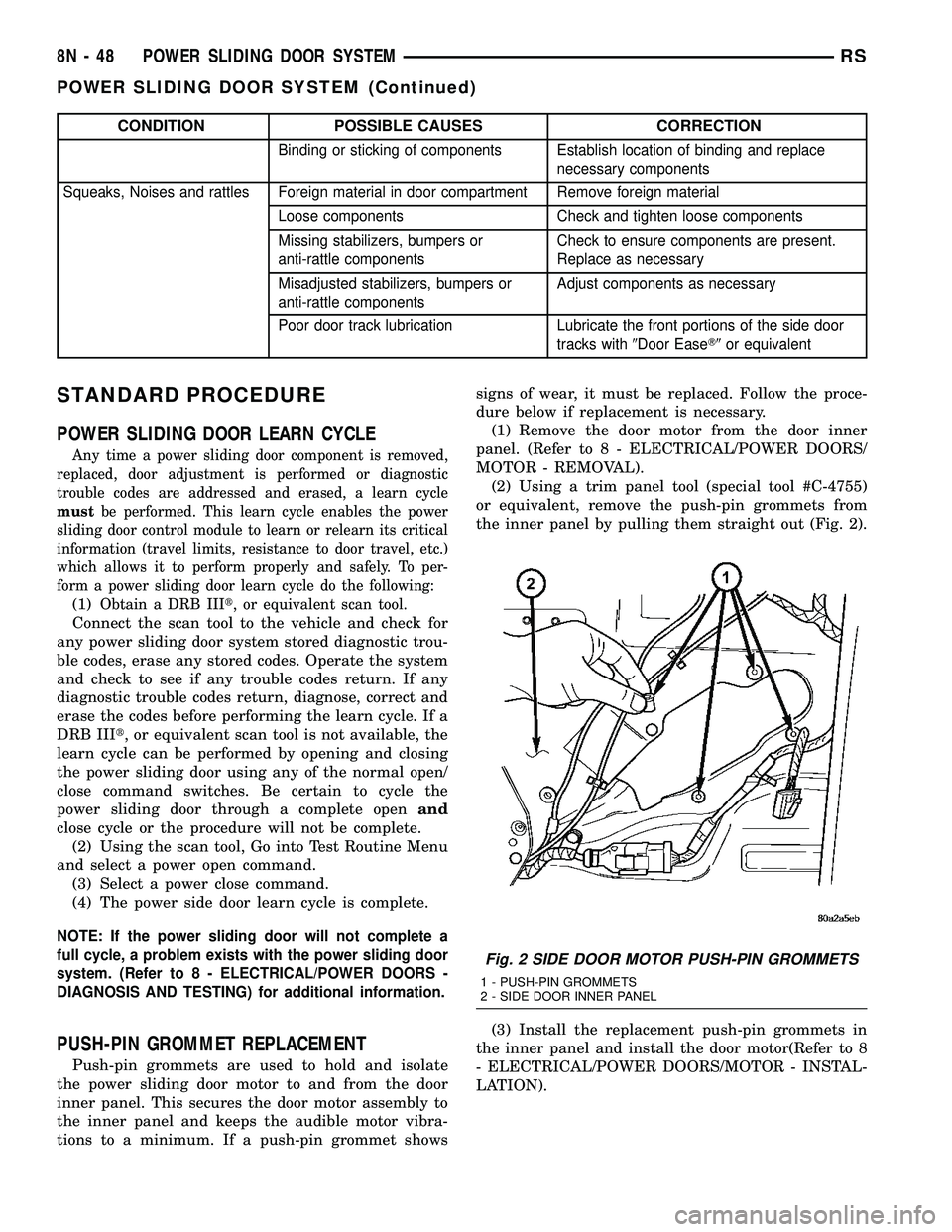
CONDITION POSSIBLE CAUSES CORRECTION
Binding or sticking of components Establish location of binding and replace
necessary components
Squeaks, Noises and rattles Foreign material in door compartment Remove foreign material
Loose components Check and tighten loose components
Missing stabilizers, bumpers or
anti-rattle componentsCheck to ensure components are present.
Replace as necessary
Misadjusted stabilizers, bumpers or
anti-rattle componentsAdjust components as necessary
Poor door track lubrication Lubricate the front portions of the side door
tracks with9Door EaseT9or equivalent
STANDARD PROCEDURE
POWER SLIDING DOOR LEARN CYCLE
Any time a power sliding door component is removed,
replaced, door adjustment is performed or diagnostic
trouble codes are addressed and erased, a learn cycle
mustbe performed. This learn cycle enables the power
sliding door control module to learn or relearn its critical
information (travel limits, resistance to door travel, etc.)
which allows it to perform properly and safely. To per-
form a power sliding door learn cycle do the following:
(1)Obtain a DRB IIIt, or equivalent scan tool.
Connect the scan tool to the vehicle and check for
any power sliding door system stored diagnostic trou-
ble codes, erase any stored codes. Operate the system
and check to see if any trouble codes return. If any
diagnostic trouble codes return, diagnose, correct and
erase the codes before performing the learn cycle. If a
DRB IIIt, or equivalent scan tool is not available, the
learn cycle can be performed by opening and closing
the power sliding door using any of the normal open/
close command switches. Be certain to cycle the
power sliding door through a complete openand
close cycle or the procedure will not be complete.
(2) Using the scan tool, Go into Test Routine Menu
and select a power open command.
(3) Select a power close command.
(4) The power side door learn cycle is complete.
NOTE: If the power sliding door will not complete a
full cycle, a problem exists with the power sliding door
system. (Refer to 8 - ELECTRICAL/POWER DOORS -
DIAGNOSIS AND TESTING) for additional information.
PUSH-PIN GROMMET REPLACEMENT
Push-pin grommets are used to hold and isolate
the power sliding door motor to and from the door
inner panel. This secures the door motor assembly to
the inner panel and keeps the audible motor vibra-
tions to a minimum. If a push-pin grommet showssigns of wear, it must be replaced. Follow the proce-
dure below if replacement is necessary.
(1) Remove the door motor from the door inner
panel. (Refer to 8 - ELECTRICAL/POWER DOORS/
MOTOR - REMOVAL).
(2) Using a trim panel tool (special tool #C-4755)
or equivalent, remove the push-pin grommets from
the inner panel by pulling them straight out (Fig. 2).
(3) Install the replacement push-pin grommets in
the inner panel and install the door motor(Refer to 8
- ELECTRICAL/POWER DOORS/MOTOR - INSTAL-
LATION).
Fig. 2 SIDE DOOR MOTOR PUSH-PIN GROMMETS
1 - PUSH-PIN GROMMETS
2 - SIDE DOOR INNER PANEL
8N - 48 POWER SLIDING DOOR SYSTEMRS
POWER SLIDING DOOR SYSTEM (Continued)
Page 472 of 2339
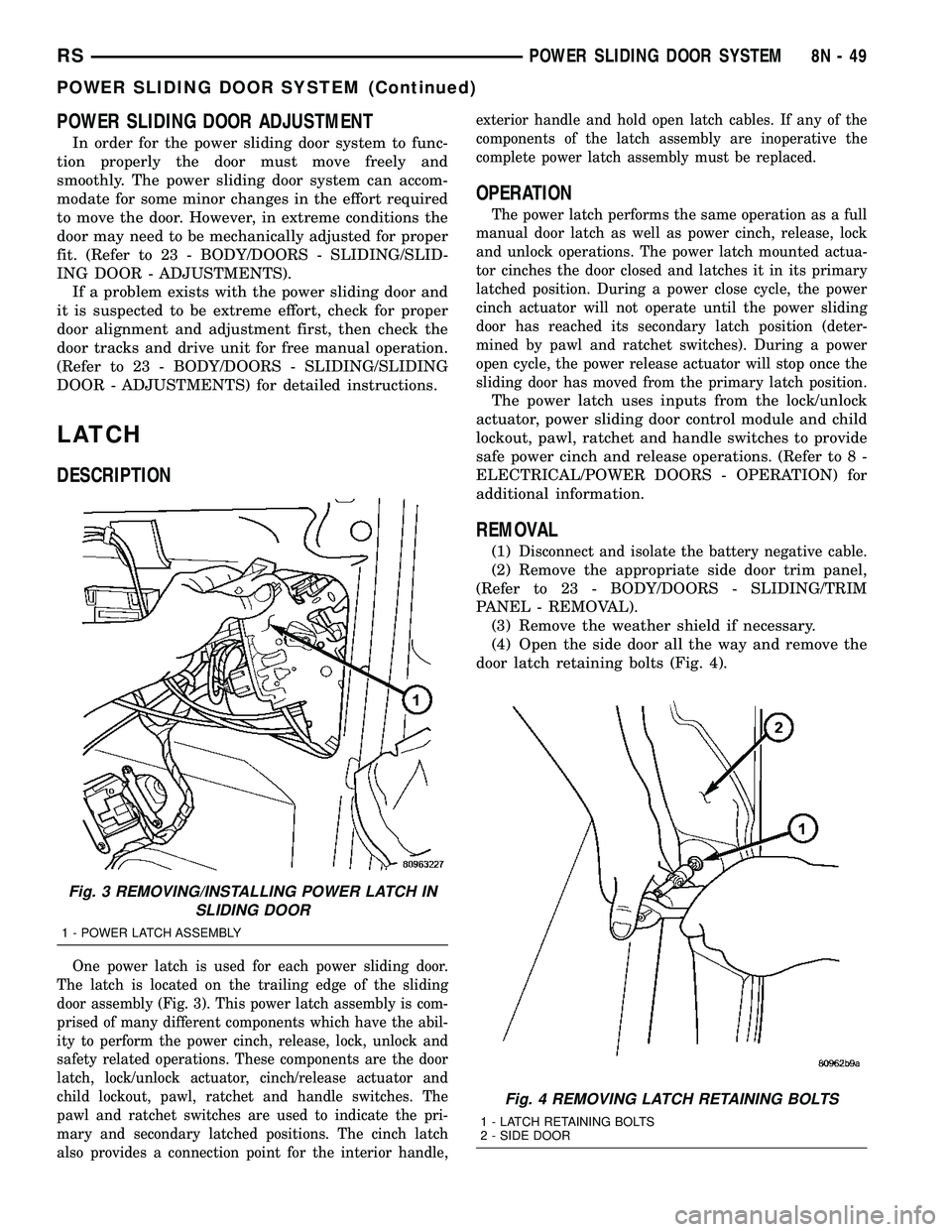
POWER SLIDING DOOR ADJUSTMENT
In order for the power sliding door system to func-
tion properly the door must move freely and
smoothly. The power sliding door system can accom-
modate for some minor changes in the effort required
to move the door. However, in extreme conditions the
door may need to be mechanically adjusted for proper
fit. (Refer to 23 - BODY/DOORS - SLIDING/SLID-
ING DOOR - ADJUSTMENTS).
If a problem exists with the power sliding door and
it is suspected to be extreme effort, check for proper
door alignment and adjustment first, then check the
door tracks and drive unit for free manual operation.
(Refer to 23 - BODY/DOORS - SLIDING/SLIDING
DOOR - ADJUSTMENTS) for detailed instructions.
LATCH
DESCRIPTION
One power latch is used for each power sliding door.
The latch is located on the trailing edge of the sliding
door assembly (Fig. 3). This power latch assembly is com-
prised of many different components which have the abil-
ity to perform the power cinch, release, lock, unlock and
safety related operations. These components are the door
latch, lock/unlock actuator, cinch/release actuator and
child lockout, pawl, ratchet and handle switches. The
pawl and ratchet switches are used to indicate the pri-
mary and secondary latched positions. The cinch latch
also provides a connection point for the interior handle,exterior handle and hold open latch cables. If any of the
components of the latch assembly are inoperative the
complete power latch assembly must be replaced.
OPERATION
The power latch performs the same operation as a full
manual door latch as well as power cinch, release, lock
and unlock operations. The power latch mounted actua-
tor cinches the door closed and latches it in its primary
latched position. During a power close cycle, the power
cinch actuator will not operate until the power sliding
door has reached its secondary latch position (deter-
mined by pawl and ratchet switches). During a power
open cycle, the power release actuator will stop once the
sliding door has moved from the primary latch position.
The power latch uses inputs from the lock/unlock
actuator, power sliding door control module and child
lockout, pawl, ratchet and handle switches to provide
safe power cinch and release operations. (Refer to 8 -
ELECTRICAL/POWER DOORS - OPERATION) for
additional information.
REMOVAL
(1)Disconnect and isolate the battery negative cable.
(2) Remove the appropriate side door trim panel,
(Refer to 23 - BODY/DOORS - SLIDING/TRIM
PANEL - REMOVAL).
(3) Remove the weather shield if necessary.
(4) Open the side door all the way and remove the
door latch retaining bolts (Fig. 4).
Fig. 3 REMOVING/INSTALLING POWER LATCH IN
SLIDING DOOR
1 - POWER LATCH ASSEMBLY
Fig. 4 REMOVING LATCH RETAINING BOLTS
1 - LATCH RETAINING BOLTS
2 - SIDE DOOR
RSPOWER SLIDING DOOR SYSTEM8N-49
POWER SLIDING DOOR SYSTEM (Continued)
Page 473 of 2339

(5) Partially close the door and pull the latch
assembly out of the side door inner panel, (Fig. 5).
(6) Disconnect all electrical connectors leading to
the latch assembly.
(7) Disconnect the inside and outside handle cables
from the latch assembly.
(8) Disconnect the hold open latch cable from the
latch assembly.
(9) Disconnect lock actuator link rod from the
latch assembly.
(10) Remove the latch assembly from the vehicle.
INSTALLATION
(1) Position the latch assembly in the vehicle. Be
certain all latch mounted components are installed
on the replacement latch assembly. If not, transfer
components from the old latch to the new latch
assembly, (Fig. 6).
(2) Connect the lock actuator link rod on the latch
assembly.
(3) Connect the hold open latch cable on the latch
assembly.
(4) Connect the inside and outside handle cables
on the latch assembly.
(5) Connect all electrical connectors leading to the
latch assembly.
(6) With assistance from another person, position
the side door and install the door latch retaining
bolts, (Fig. 7). Torque to 10 - 12 N´m (100 in. lbs.).
(7) Install the weathershield if necessary.(8) Install the appropriate side door trim panel,
(Refer to 23 - BODY/DOORS - SLIDING/TRIM
PANEL - INSTALLATION) for detailed instructions.
(9) Connect the negative battery cable.
Fig. 5 POWER LATCH POSITION & ORIENTATION
1 - POWER LATCH ASSEMBLY
Fig. 6 POWER LATCH POSITION & ORIENTATION
1 - POWER LATCH ASSEMBLY
Fig. 7 REMOVING LATCH RETAINING BOLTS
1 - LATCH RETAINING BOLTS
2 - SIDE DOOR
8N - 50 POWER SLIDING DOOR SYSTEMRS
LATCH (Continued)
Page 474 of 2339

SLIDING DOOR MOTOR
DESCRIPTION
The door motor is located in the center of the
power sliding door (Fig. 8) and is comprised of three
parts. The three parts of the door motor assembly are
the motor, gear reduction and clutch assembly. The
door motor assembly provides the power and torque
to move the sliding door from the open/closed posi-
tion to full closed/open position, after the power
latching mechanism has released.
The door motor is replaced as a complete assembly,
which includes the DC motor, gear reduction and
clutch assemblies.
OPERATION
With the push of a power sliding door command
switch, the power sliding door control module will
signal the latch assembly to release the door from its
primary locked position. The door motor will then
take over to provide the power to open the door to its
full open or closed position. The gear reduction por-
tion of the motor assembly reduces the speed of the
motor from 5800 to 260 rpm and also increases the
torque to the lower drive unit. The clutch portion of
the motor assembly engages the motor to drive thedoor under power and disengages it so the door can
be moved easily under manual operation.
REMOVAL
(1) Disconnect and isolate the battery negative
cable.
(2) Remove the door trim panel from the appropri-
ate door, (Refer to 23 - BODY/DOORS - SLIDING/
TRIM PANEL - REMOVAL).
(3) Remove the water shield as necessary to gain
access to motor assembly.
(4) Remove retaining clip holding flex drive assem-
bly to the motor (Fig. 9). Pull flex drive cable straight
out of the motor assembly.
(5) Disconnect door motor electrical connector.
(6) Using a trim stick (special tool #C-4755) or
equivalent, gently pry out push-pin fasteners retain-
ing the door motor.
(7) Remove the door motor assembly from the
vehicle.
INSTALLATION
(1) Position the door motor assembly on the door
inner panel.
(2) Install the push-pin fasteners retaining the
motor assembly to the power sliding door.
Fig. 8 POWER SLIDING DOOR COMPONENTS
1 - POWER SLIDING DOOR CONTROL MODULE
2 - MODULE RETAINING SCREW
3 - MODULE ELECTRICAL CONNECTORS
4 - DOOR MOTOR ASSEMBLY
5 - FLEX DRIVE ASSEMBLY
6 - DOOR MOTOR RETAINING FASTENERS
7 - DOOR MOTOR ELECTRICAL CONNECTOR
Fig. 9 FLEX DRIVE RETAINING CLIP
1 - FLEX DRIVE CABLE RETAINING CLIP
2 - FLEX DRIVE CABLE
3 - DOOR MOTOR ASSEMBLY
RSPOWER SLIDING DOOR SYSTEM8N-51
Page 475 of 2339
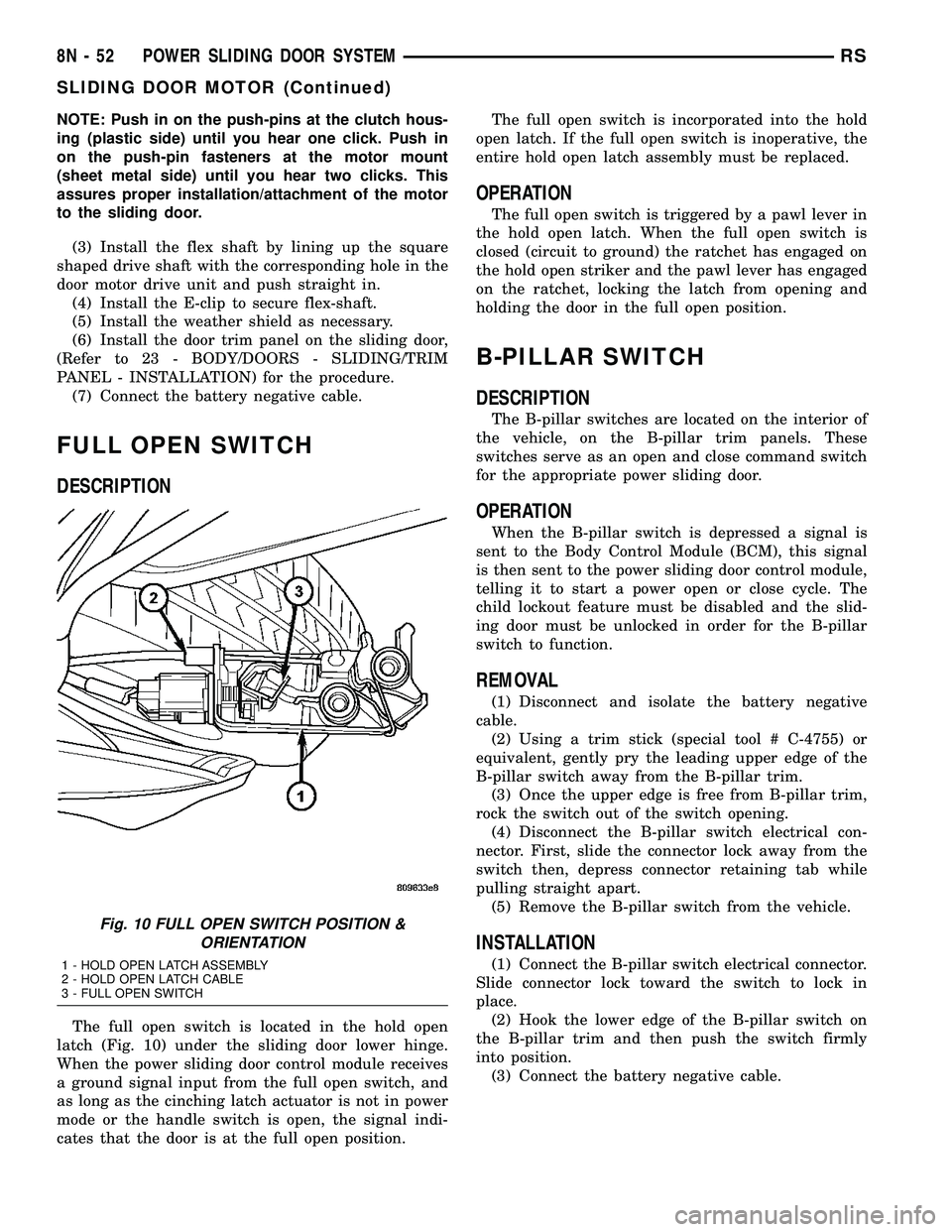
NOTE: Push in on the push-pins at the clutch hous-
ing (plastic side) until you hear one click. Push in
on the push-pin fasteners at the motor mount
(sheet metal side) until you hear two clicks. This
assures proper installation/attachment of the motor
to the sliding door.
(3) Install the flex shaft by lining up the square
shaped drive shaft with the corresponding hole in the
door motor drive unit and push straight in.
(4) Install the E-clip to secure flex-shaft.
(5) Install the weather shield as necessary.
(6) Install the door trim panel on the sliding door,
(Refer to 23 - BODY/DOORS - SLIDING/TRIM
PANEL - INSTALLATION) for the procedure.
(7) Connect the battery negative cable.
FULL OPEN SWITCH
DESCRIPTION
The full open switch is located in the hold open
latch (Fig. 10) under the sliding door lower hinge.
When the power sliding door control module receives
a ground signal input from the full open switch, and
as long as the cinching latch actuator is not in power
mode or the handle switch is open, the signal indi-
cates that the door is at the full open position.The full open switch is incorporated into the hold
open latch. If the full open switch is inoperative, the
entire hold open latch assembly must be replaced.
OPERATION
The full open switch is triggered by a pawl lever in
the hold open latch. When the full open switch is
closed (circuit to ground) the ratchet has engaged on
the hold open striker and the pawl lever has engaged
on the ratchet, locking the latch from opening and
holding the door in the full open position.
B-PILLAR SWITCH
DESCRIPTION
The B-pillar switches are located on the interior of
the vehicle, on the B-pillar trim panels. These
switches serve as an open and close command switch
for the appropriate power sliding door.
OPERATION
When the B-pillar switch is depressed a signal is
sent to the Body Control Module (BCM), this signal
is then sent to the power sliding door control module,
telling it to start a power open or close cycle. The
child lockout feature must be disabled and the slid-
ing door must be unlocked in order for the B-pillar
switch to function.
REMOVAL
(1) Disconnect and isolate the battery negative
cable.
(2) Using a trim stick (special tool # C-4755) or
equivalent, gently pry the leading upper edge of the
B-pillar switch away from the B-pillar trim.
(3) Once the upper edge is free from B-pillar trim,
rock the switch out of the switch opening.
(4) Disconnect the B-pillar switch electrical con-
nector. First, slide the connector lock away from the
switch then, depress connector retaining tab while
pulling straight apart.
(5) Remove the B-pillar switch from the vehicle.
INSTALLATION
(1) Connect the B-pillar switch electrical connector.
Slide connector lock toward the switch to lock in
place.
(2) Hook the lower edge of the B-pillar switch on
the B-pillar trim and then push the switch firmly
into position.
(3) Connect the battery negative cable.
Fig. 10 FULL OPEN SWITCH POSITION &
ORIENTATION
1 - HOLD OPEN LATCH ASSEMBLY
2 - HOLD OPEN LATCH CABLE
3 - FULL OPEN SWITCH
8N - 52 POWER SLIDING DOOR SYSTEMRS
SLIDING DOOR MOTOR (Continued)
Page 478 of 2339

FLEX DRIVE
DESCRIPTION
The flex drive assembly is located in the lower por-
tion of the power sliding door (Fig. 17) and is used to
connect the door motor to the lower drive unit. An
E-clip is used to secure the flex drive to the motor
assembly, while the flex drive collar is used to secure
the drive to the lower drive unit. The flex drive
assembly is basically a flexible drive shaft for the
power sliding door system. The flex drive assembly is
a replaceable component.
OPERATION
With one end of the flex drive attached to the door
motor and the other attached to the lower drive unit,the flex drive transfers the power and torque from
the motor to the drive unit. A square shaped drive
cable, inside the flex drive assembly engages the
motor drive and rotates to move the door accordingly.
REMOVAL
(1) Disconnect and isolate the battery negative
cable.
(2) Remove the appropriate sliding door trim
panel, (Refer to 23 - BODY/DOORS - SLIDING/TRIM
PANEL - REMOVAL).
(3) Position the weathershield aside to gain access
to the flex drive assembly.
(4) Remove the E-clip from the flex drive assembly
(Fig. 18).
(5) Pull the flex drive straight out of the motor
assembly.
Fig. 17 POWER SLIDING DOOR COMPONENTS
1 - POWER SLIDING DOOR CONTROL MODULE
2 - MODULE RETAINING SCREW
3 - MODULE ELECTRICAL CONNECTORS
4 - DOOR MOTOR ASSEMBLY
5 - FLEX DRIVE ASSEMBLY
6 - DOOR MOTOR RETAINING FASTENERS
7 - DOOR MOTOR ELECTRICAL CONNECTOR
Fig. 18 FLEX DRIVE E-CLIP
1 - FLEX DRIVE CABLE RETAINING CLIP
2 - FLEX DRIVE CABLE
3 - DOOR MOTOR ASSEMBLY
RSPOWER SLIDING DOOR SYSTEM8N-55
Page 479 of 2339
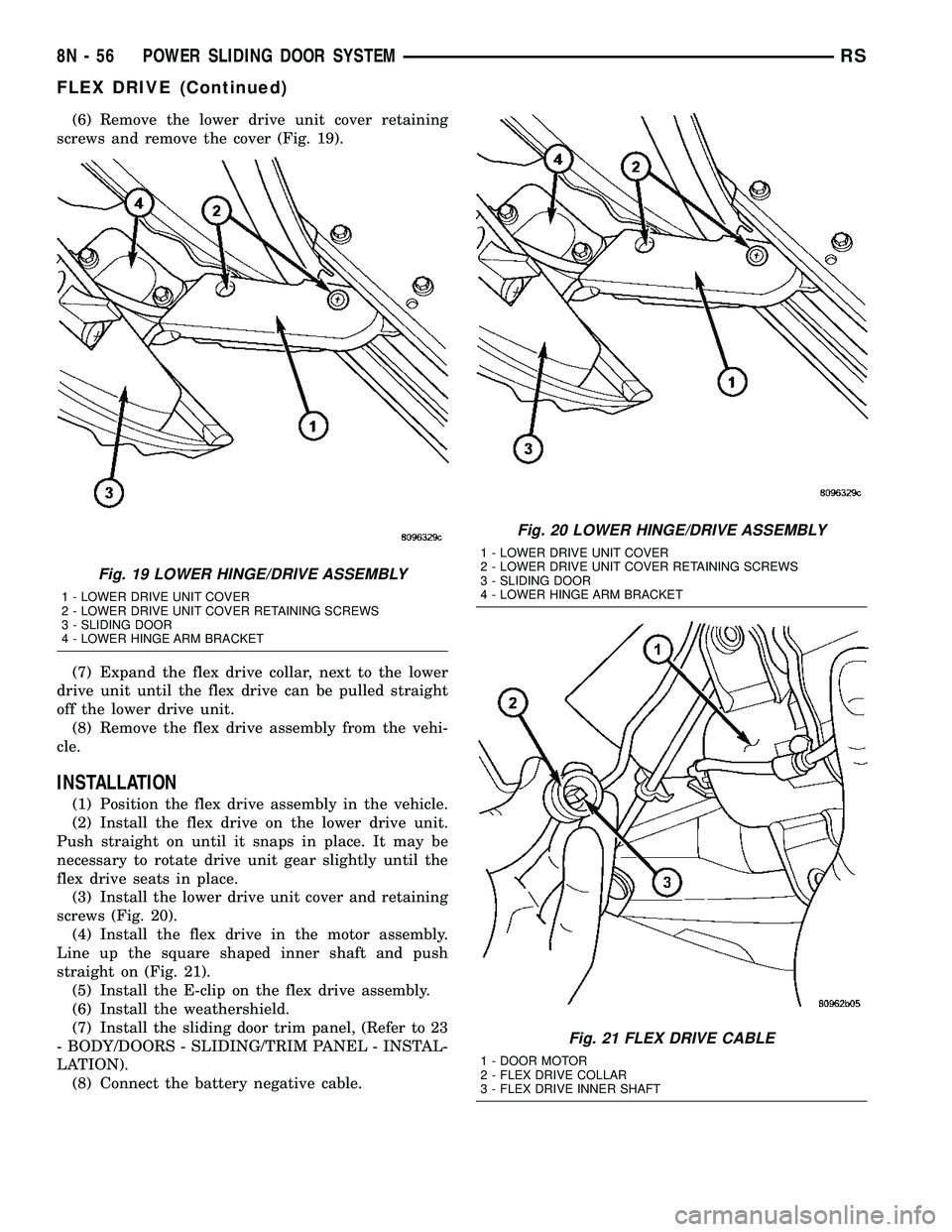
(6) Remove the lower drive unit cover retaining
screws and remove the cover (Fig. 19).
(7) Expand the flex drive collar, next to the lower
drive unit until the flex drive can be pulled straight
off the lower drive unit.
(8) Remove the flex drive assembly from the vehi-
cle.
INSTALLATION
(1) Position the flex drive assembly in the vehicle.
(2) Install the flex drive on the lower drive unit.
Push straight on until it snaps in place. It may be
necessary to rotate drive unit gear slightly until the
flex drive seats in place.
(3) Install the lower drive unit cover and retaining
screws (Fig. 20).
(4) Install the flex drive in the motor assembly.
Line up the square shaped inner shaft and push
straight on (Fig. 21).
(5) Install the E-clip on the flex drive assembly.
(6) Install the weathershield.
(7) Install the sliding door trim panel, (Refer to 23
- BODY/DOORS - SLIDING/TRIM PANEL - INSTAL-
LATION).
(8) Connect the battery negative cable.
Fig. 19 LOWER HINGE/DRIVE ASSEMBLY
1 - LOWER DRIVE UNIT COVER
2 - LOWER DRIVE UNIT COVER RETAINING SCREWS
3 - SLIDING DOOR
4 - LOWER HINGE ARM BRACKET
Fig. 20 LOWER HINGE/DRIVE ASSEMBLY
1 - LOWER DRIVE UNIT COVER
2 - LOWER DRIVE UNIT COVER RETAINING SCREWS
3 - SLIDING DOOR
4 - LOWER HINGE ARM BRACKET
Fig. 21 FLEX DRIVE CABLE
1 - DOOR MOTOR
2 - FLEX DRIVE COLLAR
3 - FLEX DRIVE INNER SHAFT
8N - 56 POWER SLIDING DOOR SYSTEMRS
FLEX DRIVE (Continued)
Page 480 of 2339
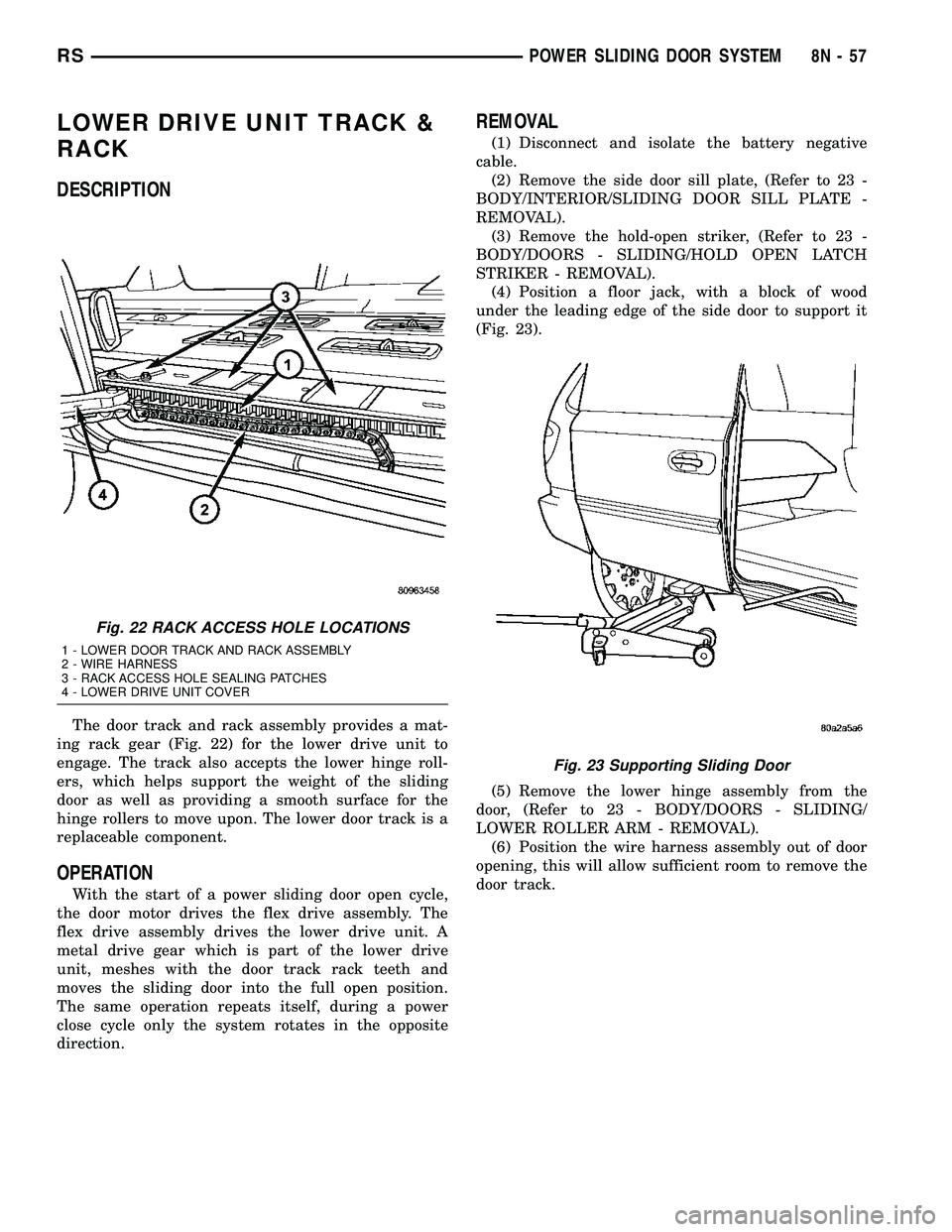
LOWER DRIVE UNIT TRACK &
RACK
DESCRIPTION
The door track and rack assembly provides a mat-
ing rack gear (Fig. 22) for the lower drive unit to
engage. The track also accepts the lower hinge roll-
ers, which helps support the weight of the sliding
door as well as providing a smooth surface for the
hinge rollers to move upon. The lower door track is a
replaceable component.
OPERATION
With the start of a power sliding door open cycle,
the door motor drives the flex drive assembly. The
flex drive assembly drives the lower drive unit. A
metal drive gear which is part of the lower drive
unit, meshes with the door track rack teeth and
moves the sliding door into the full open position.
The same operation repeats itself, during a power
close cycle only the system rotates in the opposite
direction.
REMOVAL
(1) Disconnect and isolate the battery negative
cable.
(2) Remove the side door sill plate, (Refer to 23 -
BODY/INTERIOR/SLIDING DOOR SILL PLATE -
REMOVAL).
(3) Remove the hold-open striker, (Refer to 23 -
BODY/DOORS - SLIDING/HOLD OPEN LATCH
STRIKER - REMOVAL).
(4) Position a floor jack, with a block of wood
under the leading edge of the side door to support it
(Fig. 23).
(5) Remove the lower hinge assembly from the
door, (Refer to 23 - BODY/DOORS - SLIDING/
LOWER ROLLER ARM - REMOVAL).
(6) Position the wire harness assembly out of door
opening, this will allow sufficient room to remove the
door track.
Fig. 22 RACK ACCESS HOLE LOCATIONS
1 - LOWER DOOR TRACK AND RACK ASSEMBLY
2 - WIRE HARNESS
3 - RACK ACCESS HOLE SEALING PATCHES
4 - LOWER DRIVE UNIT COVER
Fig. 23 Supporting Sliding Door
RSPOWER SLIDING DOOR SYSTEM8N-57